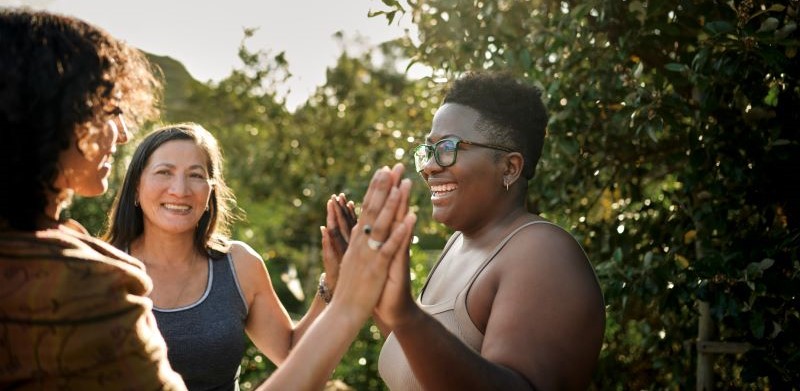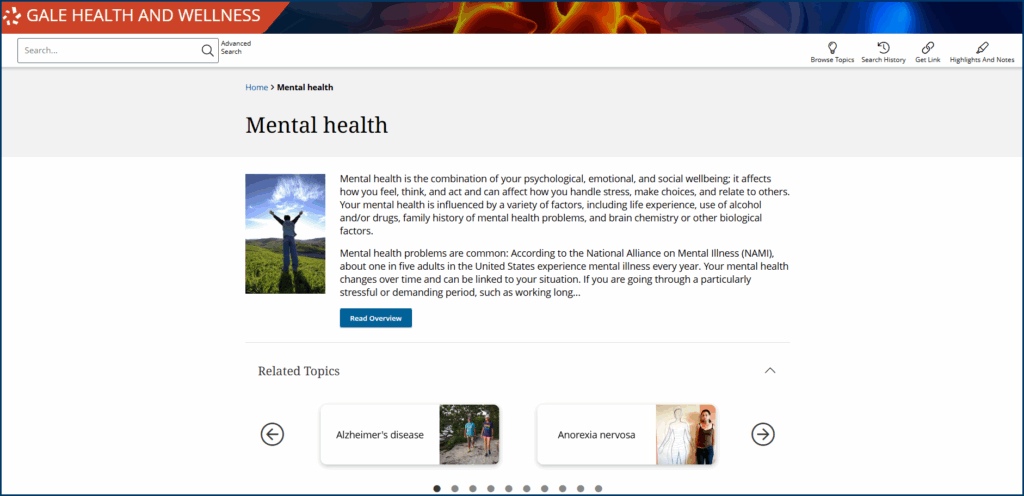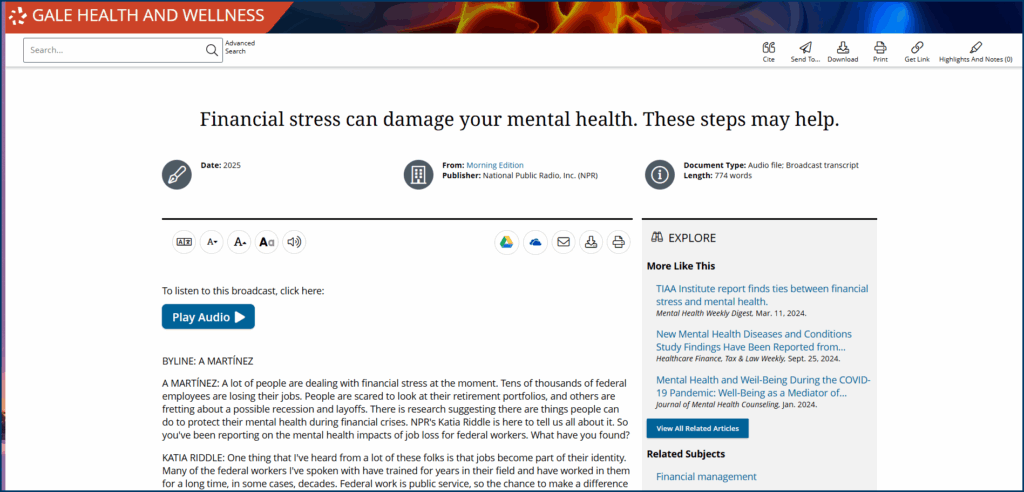Mental health concerns don’t always begin with a crisis. Often, the first signs are easy to explain away—irritability because there’s too much going on at work, or feeling blue because it’s been a bad week.
At that point, people aren’t looking for a diagnosis. They’re trying to manage on their own—searching for stress management tips, downloading mindfulness apps, or checking forums to evaluate their symptoms. While some of these resources can be helpful, others may be inconsistent or commercialized, making it hard to know what’s trustworthy.
With World Mental Health Day coming up on October 10, now is a great time to broaden the conversation with the dedicated mental health topic page on Gale Health and Wellness. The platform brings together trusted reference materials, medically reviewed articles, and a range of curated stories from programs like All Things Considered to humanize the topic. We designed Gale Health and Wellness with the everyday user in mind, so that your patrons can research serious topics in a safe, ad-free environment.
Start with Trusted, Responsible Resources
Anyone with an internet connection has no shortage of medical information at their fingertips. The challenge is finding a source that presents health content responsibly by avoiding sensationalism and prioritizing medical accuracy. Gale Health and Wellness bridges that gap with materials that make complicated topics accessible to a broader audience without oversimplifying key ideas.
When libraries invest in Gale Health and Wellness, they’re providing patrons with a thoughtful alternative to the often overwhelming or inconsistent health information found online. The platform organizes content around real-world questions—what someone might actually type into a search bar—so users don’t have to translate their concerns into clinical terms to find the answers they need.
With a strong foundation of accessible, well-structured information, libraries can build responsible mental health programming that reflects your community’s needs and values. Let’s consider some key points to help you get started.
Recognize Cultural and Social Factors Impacting Mental Health
Despite growing public awareness, mental health remains a taboo topic, particularly for men and members of historically marginalized communities. Whether due to cultural expectations, bias within healthcare systems, or media representation, these groups are often less likely to seek help when their mental health is under strain.
As mental health activist Dior Vargas reflected in an interview about stigma and disparities in care: “I always felt like I was the only one . . . When people talk about mental illness, when it’s discussed or shown through the media, they never really show people of color.”
For groups already less likely to seek help, a lack of representation in mental health resources can reinforce the idea that those services aren’t meant for them.
Libraries with access to Gale Health and Wellness can counter that by prioritizing an inclusive approach to mental health support that validates the lived experiences of the communities they serve and sharing stories that resonate with different identities.
In addition to highlighting Gale content that addresses these gaps, libraries might also point patrons toward trusted organizations that focus on community-specific support—such as Movember for men’s mental health, The Trevor Project for LGBTQ+ youth, or the Black Emotional and Mental Health Collective (BEAM). Including these resources alongside information from Gale Health and Wellness helps patrons understand that they aren’t the only ones to experience what they might be going through.
The Impact of Finances on Men’s Mental Health
Financial stress isn’t unique to men—but studies show that they may have a harder time opening up and discussing it than others.
Beyond Finance conducted a national survey of 2,000 men that found that just 15% of men—fewer than one in six—rated their financial health as excellent. More tellingly, 30% reported anxiety related to their finances, 28% said they felt overwhelmed, and 19% admitted to feeling embarrassed.
Gale Health and Wellness gives patrons a place to explore these connections at their own pace, with resources that speak directly to the challenges they are facing.
Using the “Search within results” feature on the mental health topic page, patrons can filter for terms like “financial health” to hone in on the most relevant materials. They might begin with the audio tab to listen to Morning Edition’s “Financial Stress Can Damage Your Mental Health. These Steps May Help.”
Gale Health and Wellness also offers daily news updates on emerging mental health topics, helping patrons stay informed on how current events may be influencing their well-being. Articles such as “How to Cope with Financial Stress Affecting Your Mental Health” provide practical advice on “. . . improv[ing] how you feel about, think about and behave with money,” while studies like “‘Stressflation’ Is Here: 83% of Americans Say Today’s Economic Climate Is Taking a Toll on Their Mental Health” remind readers they are not alone.
Pair Digital Resources with Accessibility Tools to Reach More People
Stress and mental health challenges, including depression and anxiety, are linked to reduced working memory and slower processing speeds, both of which can make it more difficult to retain or understand material. Gale Health and Wellness meets people where they’re at. With an integrated accessibility toolbar on every page of the platform, your community can engage with the resources in ways that best meet their needs.
For example, patrons can listen to articles out loud while viewing enlarged text with enhanced text visibility, adjust font size and display options to reduce visual strain, or translate content into more than 40 languages. Paired with audio and video formats, these features remove barriers to mental health information, so users don’t have to fight through formatting to get equitable access to the content.
Become a Gathering Place to Combat Loneliness
In 2023, Vivek Murthy, the US surgeon general, declared loneliness a public health crisis, citing research linking “poor or insufficient social connection” with an increased risk of heart disease and risk of stroke, as well as dementia and depression.
In Murthy’s report, “Our Epidemic of Loneliness and Isolation,” he suggests that the mortality impact of being socially disconnected is similar to that caused by smoking up to 15 cigarettes a day, and even greater than that associated with obesity and physical inactivity.
About half of American adults have experienced loneliness, yet it continues to be treated as a private, emotional failure rather than a widespread health issue. It’s a perception gap that leaves many people suffering in silence, unsure of how to ask for help.
Create On-Ramps for Socially Isolated Community Members
Libraries, perhaps more than any other community space, are equipped to intervene by connecting community members. Programs that encourage shared presence without requiring direct interaction offer a gentler, more approachable way to engage.
Silent book clubs have become increasingly popular, and there’s minimal prep beyond a reserved space and a few comfortable seats. Participants gather to read a book of the individual’s choosing in the same space, with no expectation of social interaction. Some libraries choose to include a short, optional discussion at the end, often guided by a volunteer facilitator, so that those who want to connect with others can talk about what they’re reading. However, the overarching goal should be to create a setting where people can just enjoy a good book while others do the same.
That sense of shared presence without pressure to perform makes this format effective. For those living with social anxiety or chronic loneliness, this low-stakes setting offers structure, routine, and a sense of belonging without requiring small talk or self-disclosure.
Other soft-entry formats can serve similar purposes. Intergenerational programming, for example, can be especially meaningful for older adults, who are among the most at risk for chronic loneliness. Consider letting seniors read during a weekly children’s story time or inviting them to participate in collaborative art projects, creating natural opportunities for conversation across age groups.
Hosting this kind of program also provides further invitation for people to visit the library, underscoring its centrality to the broader community as a place of connection and understanding, with a wealth of resources that affirm emotional well-being as a core part of daily life.
Contact your local Gale sales representative to preview how Gale Health and Wellness can connect your community to trustworthy mental health information.



